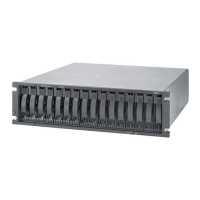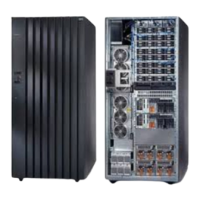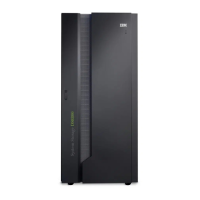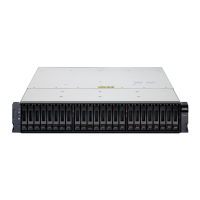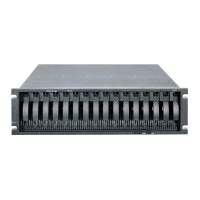1. With both levers rotated out perpendicular to the face of the component, slide
the back of the component into the appropriate slot.
2. Push the component into the slot and, when the component is almost fully
installed, verify that the notches in both levers are aligned with the pins on the
storage subsystem. Verify this alignment to ensure that the component is pulled
evenly into the storage subsystem, ensuring full electrical connection contact on
all interface pins.
3. Press the component fully into the slot, engaging the pins on the storage
subsystem.
4. Hold open both latches and rotate both levers simultaneously to the closed
position. Release the latches. When you release the latches, you should hear
both latches snap over the levers. This indicates that the component is locked in
place.
Replacing a controller
Attention: Before you replace a RAID controller, verify the following:
v The replacement RAID controller part number matches the part number of the
RAID controller to be replaced. To provide full functionality, the two controllers
should have the same memory capacity. Although two controllers of different
memories can be paired in an storage subsystem, the mismatch causes some
functions to be disabled (for example, the cache mirroring function).
v Inserting a DS4800 model 80A/H controller into a non-model 80A/H DS4800
subsystems (that is, model 82A/H, model 84A/H, model 88A/H) will result in the
controller to be held in lockdown state. Similarly, inserting a non-model 80
DS4800 controller into a DS4800 model 80 subsystem will cause it to be held in
lock down state.
v Both power supply and fan units must be connected and powered on with no
lighted Needs Attention LEDs. Ensure that the Power LEDs on each of the power
supply and fan units are lit. If either of the power supply and fan units is not
optimal, it is recommended that you replace that component before you proceed
with the controller replacement procedure.
v If you are replacing an optimal controller, first make sure that the other RAID
controller is optimal and that the fibre channel path from the hosts to the other
RAID controller is also optimal.
Use
the following procedure to replace a controller in an DS4800 Storage
Subsystem.
Attention: If you are upgrading controllers you received through an upgrade kit,
refer to “Upgrading controllers” on page 150 and use the instructions provided in
the upgrade kit to replace the controllers instead of the instructions in this section.
Each RAID controller has a unique hardware Ethernet address, which is printed on
a label on the front.
1. Use the DS4000 Storage Manager client software to print a storage subsystem
profile. Move logical drive ownership to the other controller. If the controller you
are replacing has failed but is still operating, move the failed controller to an
Offline state.
Attention: Never remove a controller unless the Service Action Allowed
status LED is turned on. Doing so can result in a potential loss of data.
2. Locate the failed controller by checking the Needs Attention status LEDs on
the controllers in the storage subsystem. (Figure 86 on page 146 shows the
Chapter 5. Replacing components 145
